Single-cell RNA sequencing reveals that MYBL2 in malignant epithelial cells is involved in the development and progression of ovarian cancer
- PMID: 39136009
- PMCID: PMC11317301
- DOI: 10.3389/fimmu.2024.1438198
Single-cell RNA sequencing reveals that MYBL2 in malignant epithelial cells is involved in the development and progression of ovarian cancer
Abstract
Background: Ovarian carcinoma (OC) is a prevalent gynecological malignancy associated with high recurrence rates and mortality, often diagnosed at advanced stages. Despite advances in immunotherapy, immune exhaustion remains a significant challenge in achieving optimal tumor control. However, the exploration of intratumoral heterogeneity of malignant epithelial cells and the ovarian cancer tumor microenvironment is still limited, hindering our comprehensive understanding of the disease.
Materials and methods: Utilizing single-cell RNA sequencing (scRNA-seq), we comprehensively investigated the cellular composition across six ovarian cancer patients with omental metastasis. Our focus centered on analysis of the malignant epithelial cells. Employing CytoTRACE and slingshot pseudotime analyses, we identified critical subpopulations and explored associated transcription factors (TFs) influencing ovarian cancer progression. Furthermore, by integrating clinical factors from a large cohort of bulk RNA sequencing data, we have established a novel prognostic model to investigate the impact of the tumor immune microenvironment on ovarian cancer patients. Furthermore, we have investigated the condition of immunological exhaustion.
Results: Our study identified a distinct and highly proliferative subgroup of malignant epithelial cells, known as C2 TOP2A+ TCs. This subgroup primarily consisted of patients who hadn't received neoadjuvant chemotherapy. Ovarian cancer patients with elevated TOP2A expression exhibited heightened sensitivity to neoadjuvant chemotherapy (NACT). Moreover, the transcription factor MYBL2 in this subgroup played a critical role in ovarian cancer development. Additionally, we developed an independent prognostic indicator, the TOP2A TCs Risk Score (TTRS), which revealed a correlation between the High TTRS Group and unfavorable outcomes. Furthermore, immune infiltration and drug sensitivity analyses demonstrated increased responsiveness to Paclitaxel, Cisplatin, and Gemcitabine in the Low TTRS Group.
Conclusion: This research deepens our understanding of malignant epithelial cells in ovarian cancer and enhances our knowledge of the ovarian cancer immune microenvironment and immune exhaustion. We have revealed the heightened susceptibility of the C2 TOP2A+ TCs subgroup to neoadjuvant chemotherapy and emphasized the role of MYBL2 within the C2 subgroup in promoting the occurrence and progression of ovarian cancer. These insights provide valuable guidance for the management of ovarian cancer treatment.
Keywords: epithelial cells; immune microenvironment; neoadjuvant chemotherapy; omentum; ovarian cancer; single-cell RNA sequencing.
Copyright © 2024 Shao, Lin, Xiahou, Zhao, Xu, Liu and Cai.
Conflict of interest statement
The authors declare that the research was conducted in the absence of any commercial or financial relationships that could be construed as a potential conflict of interest.
Figures


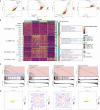
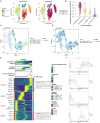
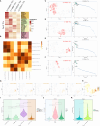
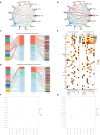

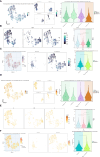
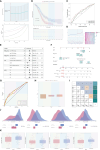
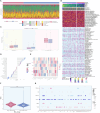
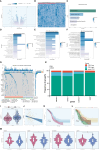

Similar articles
-
Characterizing tumor biology and immune microenvironment in high-grade serous ovarian cancer via single-cell RNA sequencing: insights for targeted and personalized immunotherapy strategies.Front Immunol. 2025 Jan 17;15:1500153. doi: 10.3389/fimmu.2024.1500153. eCollection 2024. Front Immunol. 2025. PMID: 39896800 Free PMC article.
-
Integrating Single-Cell and Bulk RNA Sequencing Data to Explore Sphingolipid Metabolism Molecular Signatures in Ovarian Cancer Prognosis: an Original Study.Int J Med Sci. 2025 Mar 24;22(8):1958-1977. doi: 10.7150/ijms.107391. eCollection 2025. Int J Med Sci. 2025. PMID: 40225866 Free PMC article.
-
Unveiling the NEFH+ malignant cell subtype: Insights from single-cell RNA sequencing in prostate cancer progression and tumor microenvironment interactions.Front Immunol. 2024 Dec 20;15:1517679. doi: 10.3389/fimmu.2024.1517679. eCollection 2024. Front Immunol. 2024. PMID: 39759507 Free PMC article.
-
Single-cell RNA sequencing in endometrial cancer: exploring the epithelial cells and the microenvironment landscape.Front Immunol. 2024 Aug 20;15:1425212. doi: 10.3389/fimmu.2024.1425212. eCollection 2024. Front Immunol. 2024. PMID: 39229264 Free PMC article. Review.
-
Impact of neoadjuvant chemotherapy on the immune microenvironment in advanced epithelial ovarian cancer: Prognostic and therapeutic implications.Int J Cancer. 2018 Jul 1;143(1):8-15. doi: 10.1002/ijc.31200. Epub 2017 Dec 23. Int J Cancer. 2018. PMID: 29218796 Review.
Cited by
-
Discovering the Potential Role of the C2 DUSP2+ MCs Subgroup in Lung Adenocarcinoma.Transl Oncol. 2025 Apr;54:102295. doi: 10.1016/j.tranon.2025.102295. Epub 2025 Feb 26. Transl Oncol. 2025. PMID: 40014976 Free PMC article.
-
Single-cell RNA sequencing in diffuse large B-cell lymphoma: tumor heterogeneity, microenvironment, resistance, and prognostic markers.Front Oncol. 2025 Apr 9;15:1583250. doi: 10.3389/fonc.2025.1583250. eCollection 2025. Front Oncol. 2025. PMID: 40270607 Free PMC article. Review.
-
A new perspective on macrophage-targeted drug research: the potential of KDELR2 in bladder cancer immunotherapy.Front Immunol. 2024 Dec 3;15:1485109. doi: 10.3389/fimmu.2024.1485109. eCollection 2024. Front Immunol. 2024. PMID: 39691708 Free PMC article.
-
Carboplatin-resistance-related DNA damage repair prognostic gene signature and its association with immune infiltration in breast cancer.Front Immunol. 2025 Jan 29;16:1522149. doi: 10.3389/fimmu.2025.1522149. eCollection 2025. Front Immunol. 2025. PMID: 39944694 Free PMC article.
-
Integrative single-cell and spatial transcriptomics uncover ELK4-mediated mechanisms in NDUFAB1+ tumor cells driving gastric cancer progression, metabolic reprogramming, and immune evasion.Front Immunol. 2025 Jul 4;16:1591123. doi: 10.3389/fimmu.2025.1591123. eCollection 2025. Front Immunol. 2025. PMID: 40688093 Free PMC article.
References
-
- Matulonis UA, Lorusso D, Oaknin A, Pignata S, Dean A, Denys H, et al. . Efficacy and safety of mirvetuximab soravtansine in patients with platinum-resistant ovarian cancer with high folate receptor alpha expression: results from the SORAYA study. J Clin Oncol. (2023) 41:2436–45. doi: 10.1200/JCO.22.01900 - DOI - PMC - PubMed
MeSH terms
Substances
LinkOut - more resources
Full Text Sources
Medical
Miscellaneous

